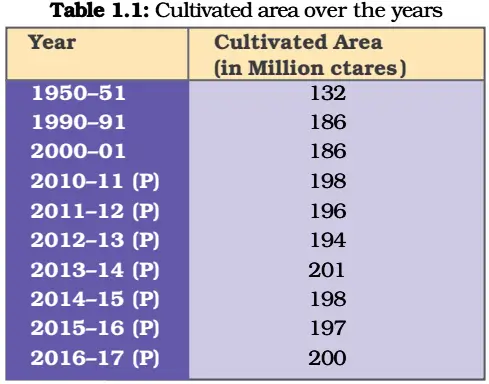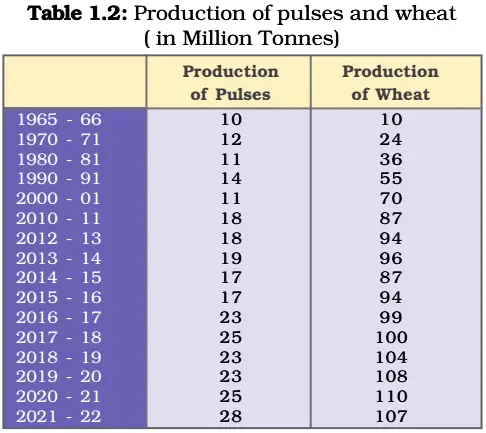NCERT Solution for Class 9 Economics Chapter 1 The Story of Village Palampur
Intext - Questions
Lets Discuss - 1
Question.1. The following table 1.1 shows that the land under cultivation in India in units of million hectares. Plot this on the graph provided.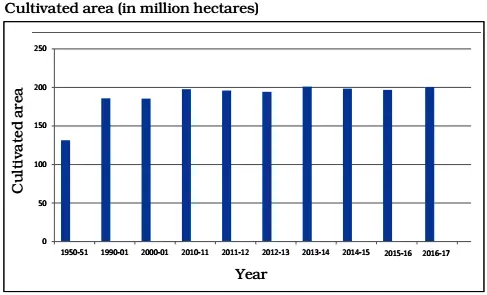
Ans. The above graph shows the land under cultivation in India in units of million hectares.
The graph shows that the land under cultivation in India was 120 million hectares in 1950 which rose to 140 million hectares in 1970 and remained constant at 140 million hectares till 2000.
(ii) Is it important to increase the area under irrigation? Why?
Ans. Yes, it is important to increase the land area under irrigation firstly so that the farmers can do multiple cropping and grow more than one crops in a year and increase their production and earning. Secondly, use of HYV seeds need of plenty of water to give best results.
(iii) You have read about the crops grown in Palampur. Fill the following table based on the information on the crops grown in your region.
Name of crops | Month sown | Month harvested | Source of irrigation |
Ans.
Name of crops | Month sown | Month harvested | Source of irrigation |
Wheat | October, December | April, July | Tubewells and canals |
Rice | June, July | September, October | Rain, canals and tubewells |
Jower and Bajra | June, July | September, October | Rain, canals and tubewells |
Lets Discuss - 2
Question.1. What is the difference between multiple cropping and modern farming method?
Ans. Multiple Cropping: To grow more than one crop on a piece of land during the year is known as multiple cropping. It is the most common way of increasing production on a given piece of land.
Modern Farming Method: The farmers of Haryana and Western Uttar Pradesh use HYV seeds, tube wells for irrigation, chemical fertilisers and pesticides, as well as machinery like tractors and threshers to increase production. All these measures comprise what are known as modern farming methods.
Question.2. The following table shows the production of wheat and pulses in India after the Green Revolution in units of million tonnes. Plot this on a graph. Was the Green Revolution equally successful for both the crops? Discuss.
Ans. Between 1965 and 2001, the production of pulses has increased negligibly whereas the production of wheat increased greatly.
Thus, we can say that the Green Revolution was more successful in increasing the production of wheat as compared to pulses.
Question.3. What is the working capital required by the farmer using modern farming methods?
Ans. The working capital required by the farmer using modern farming methods are raw material and money. Money is always required during production to make payments and buy other necessary items.
Question.4. Modern farming methods require the farmers to start with more cash than before. Why?
Ans. Modern farming methods require the use of HYV seeds which needs chemical fertilisers and pesticides to produce best results and increased production. However, for buying all these inputs a lot of money is needed so a farmer needs to have more cash to start farming.
Lets Discuss - 3
Question.1. In the picture 1.5 can you shade the land cultivated by the small farmers?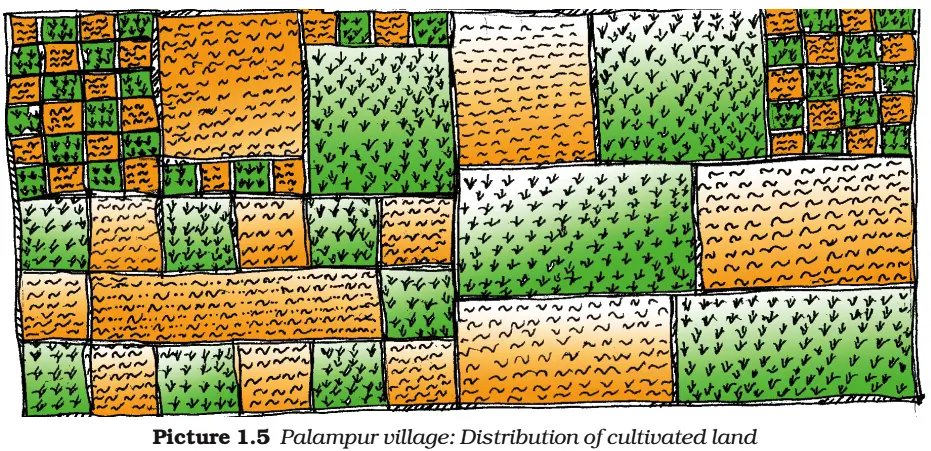
Question.2. Why do so many families of farmers cultivate such small plots of land?
Ans. Land in Palampur is fixed and 75% of the people who are working are dependent on farming for their livelihood. Since land is fixed and maximum people are dependent on land they are forced to cultivate small plots of land.
Question.3. The distribution of farmers in India and the amount of land their cultivate is given in the following graph 1.1.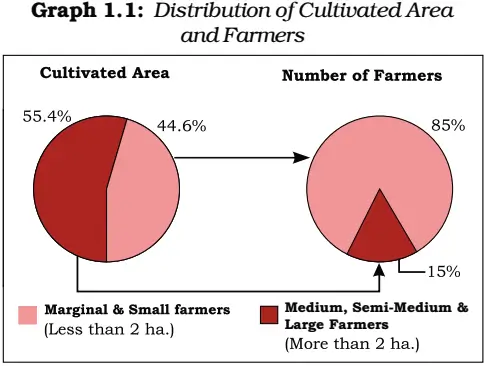
Ans. Yes, I agree that the distribution of cultivated land is unequal in Palampur because out of the 450 families, 150 families are landless, 240 families cultivate small plots of land less than 2 hectares in size whereas 60 medium and large farmers cultivate more than 2 hectares of land, a few of them have land extending over 10 hectares or more, which shows that medium and large farmers have more land though they are numerically smaller. This clearly shows the inequality in the distribution of cultivated land.
According to the graph, a similar situation exits for India also which means that 80% of the small farmers cultivate only 36% of the cultivated area whereas 20% of the big farmers cultivate 64% of the cultivated area which again shows that there is inequality in the distribution of cultivated area in the case of India also as was in Palampur.
Question.4. Identify the work being done on the field in the picture 1.6 and arrange them in proper sequence.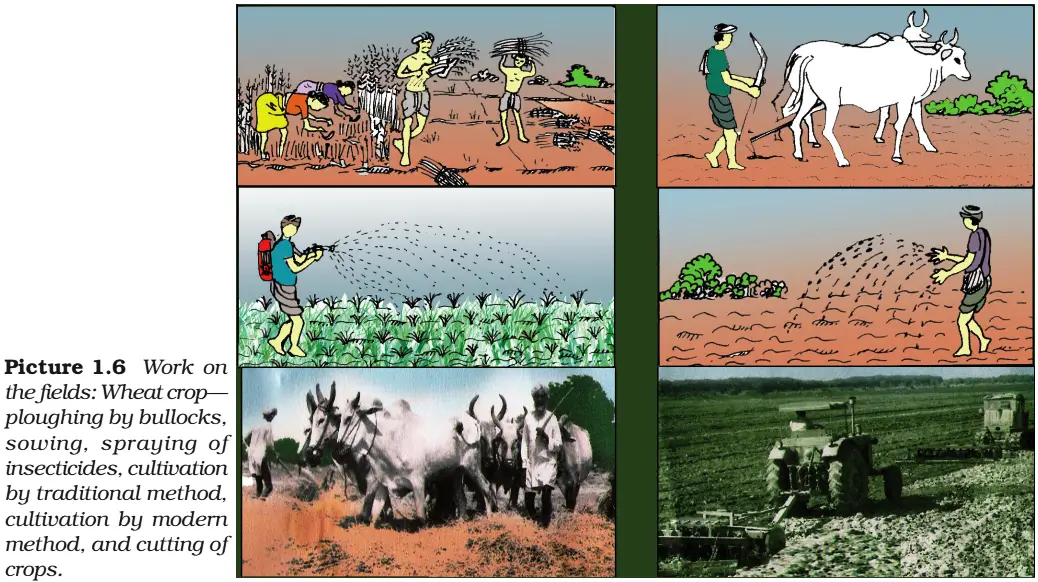
- Plowing by bullocks
- Sowing
- Spraying of insecticides
- Cultivation by traditional methods
- Cultivation by modern methods
- Cutting of crops
Lets Discuss - 4
Question.1. Why are farm labourers like Dala and Ramkali poor?
Ans.
- Dala and Ramkali are landless farm labourers who work on daily wages in Palampur.
- Though, minimum wages for farm labourers set by the government is Rs 60 per day, they get only Rs 35-40.
- There is heavy competition for work among the farm labourers in Palampur, so people agree to work for low wages.
- They remain out of work for most parts of the year and have to take loans from the moneylender to fulfill their needs. Due to this seasonal unemployment, they remain poor and are unable to repay the loan and fall into a debt trap.
Question.2. Gosaipur and Majauli are two villages in North Bihar. Out of the 850 households in the two villages there are more than 250 men who are employed in rural Punjab and Haryana or in Delhi, Mumbai, Surat, Nagpur etc.
Why do people migrate? Can you describe based on your imagination the work the migrants of Gosaipur and Majauli might do at the place of destination.
Ans. Mostly people migrate in search of employment or better job opportunities to the cities like Mumbai, Delhi etc or to the prosperous agricultural regions-like Punjab and Haryana to work as farm labourers.
- This migration usually takes place when a person is unemployed or in extreme poverty, which may be due to lack of land, displacement, negative impact of natural disasters like drought or floods, etc.
- The migrants from Gosaipur and Majauli who went to cities will probably find work as casual labourers, industrial workers, street hawkers, rickshaw pullers, headload workers or as servants in homes and hotels, etc.
- Those who went to rural areas of Punjab and Haryana will probably work as farm labourers since agriculture is the main occupation of the rural people in these states.
Question.3. Let us fill in the blanks given below.
Among the three factors of production, we found that labour is the most abundant factor of production. There are many people who are willing to work as farm labourers in the villages, whereas the opportunities of work are limited. They belong to either landless families or _________.
In contrast to labour, _________ is a scarce factor of production. Cultivated land area is _______. Moreover, even the existing land is distributed ________ (equally/ unequally) among the people engaged in farming. There are a large number of small farmers who cultivate small plots of land and live in conditions not much better than the landless farm labourer. To make the maximum use of the existing land, farmers use ________ and _________. Both these have led to increase in production of crops.
Modern farming methods require a great deal of ________. Small farmers usually need to borrow money to arrange for the capital, and are put to great distress to repay the loan. Therefore, capital too is a scarce factor of production, particularly for the small farmers.
Though both land and capital are scarce, there is a basic difference between the two factors of production. ______ is a natural resource, whereas ________ is man-made. It is possible to increase capital, whereas land is fixed. Therefore, it is very important that we take good care of land and other natural resources used in farming.
Ans. Among the three factors of production, we found that labour is the most abundant factor of production. There are many people who are willing to work as farm labourers in the villages, whereas the opportunities of work are limited. They belong to either landless families or small farmers.
In contrast to labour, land is a scarce factor of production. Cultivated land area is fixed. Moreover, even the existing land is distributed unequally among the people engaged in farming. There are a large number of small farmers who cultivate small plots of land and live in conditions not much better than the landless farm labourer. To make the maximum use of the existing land, farmers use chemical fertilizers and pesticides. Both these have led to increase in production of crops.
Modern farming methods require a great deal of capital. Small farmers usually need to borrow money to arrange for the capital, and are put to great distress to repay the loan. Therefore, capital too is a scarce factor of production, particularly for the small farmers.
Though both land and capital are scarce, there is a basic difference between the two factors of production. Land is a natural resource, whereas capital is man-made. It is possible to increase capital, whereas land is fixed. Therefore, it is very important that we take good care of land and other natural resources used in farming.
Lets Discuss - 5
Question.1. Let us take 3 farmers. Each has grown wheat on his field though the production is different (see column 2). The consumption of wheat by each family is the same (column 3). The whole of surplus wheat this year is used as capital for next years production. Also suppose, production is twice the capital used in production.
(i) Complete the tables.
(ii) Compare the production of wheat by the three farmers over the years.
Ans.
- The production of wheat of the first farmer increased from 100 to 160.
- The production of wheat of the second farmer was constant at 80.
- The production of wheat of the third farmer declined from 60 to 00.
(iii) What happens to farmer 3 in year 3? Can he continue production? What will he have to do to continue production.
Ans. In the third year, the third farmer did not produce any wheat and had to buy it from the market. He cannot continue production any longer unless he arranges capital, as he has no surplus to invest as capital.
Lets Discuss - 6
Question.1. Mishrilal has purchased a mechanical crushing machine run on electricity and has set up on his field. Sugarcane crushing was earlier done with the help of bullock, but people prefer to do it by machines these days. Mishrilal also buys sugarcane from other farmers and processes it into jaggery. The jaggery is then sold to traders as Shahpur. In this process, Mishrilal makes a small profit.
(i) What capital did Mishrilal need to set up his jaggery sugarcane manufacturing unit?
Ans. To set up his manufacturing unit Mishrilal needed the following capital
- Fixed Capital in the form of the sugarcane crushing machine.
- Working Capital in the form of money for buying sugarcane from other farmers for crushing and for paying the electricity bill of running the crushing machine.
(ii) Who provides the labour in this case?
Ans. The labour is provided by him and his family. Otherwise he will employ landless labourers.
(iii) Can you guess why Mishrilal is unable to increase his profit?
Ans.
- Mishrilal has set up a small scale unit.
- The farm holdings in the village are very small of about 2 hectares in size and production of sugarcane is low as more area is under wheat, so raw material is also less.
- He has to pay for the electricity to run the machine.
- Since the industry is small scale, production is less and therefore, he is unable to increase his profit.
(iv) Could you think of any reasons when he might face a loss?
Ans. Conditions under which he may face a loss can be any of the following:
- If his crushing machine becomes defective, his production will reduce or totally stop.
- If due to drought or other calamity, the production of sugarcane nearby areas reduces, his jaggery production will come do leading to a loss for him.
- It the demand for jaggery decreases, he will not be able to sell enough to break even.
- It any other costs like electricity, labour or transportation costs increase, he may face a loss.
(v) Why does Mishrilal sells his jaggery to traders in Shahpur and not in his village?
Ans.
- Palampur is a small village with 450 families and there is not a big demand for jaggery there.
- Shahpur is a town where people come from different surrounding villages to buy things and there is more demand of jaggery there, so Mishrilal sells his jaggery to traders in Shahpur and not in his village.
Lets Discuss - 7
Question.1. Kareem has opened a computer class centre in the village. In recent years, a large number of students have been attending college in Shahpur town. Kareem found that a number students from the village are also attending computer classes in the town. There were two women in the village who had a degree in computer applications. He decided to employ them. He bought computers and set up the classes in the front room of their house overlooking the market. High school students have started attending them in good numbers.
(i) In what way is Kareem’s capital and labour different from Mishrilal?
Ans. Both have fixed capital in the form of machines, but Kareem has a larger fixed capital because he has assets in the form of computers which are more expensive then the sugarcane crushing machine. Kareem has also employed educated and qualified computer teachers, whereas Mishrilal’s labour is mainly unskilled labour.
(ii) Why didn’t someone start a computer centre earlier? Discuss the possible reasons.
Ans. Reasons why someone didn’t start a computer centre may be any of the following:
- As very few educated people were there in the village, there was not any demand for computer courses.
- The villagers were not aware of the employment potential of computer courses and so nobody thought that such a business could be successful.
- Teaching faculty for computer courses was not available in the village earlier.
Lets Discuss - 8
Question.1. Kishora is a farm labourer. Like other such labourers, Kishora found it difficult to meet his family’s needs from the wages he received. A few years back Kishora took a loan from the bank was under a government programme which was giving cheap loans to the poor landless households. Kishora bought a buffalo with this money. He now sells the buffalo’s milk.
Further he has attached a wooden cart to his buffalo and uses it to transport various items. Once a week he goes to the river Ganga to bring back clay for the potter. 0r sometimes he goes to Shahpur with a load of jaggery or other commodities. Every month he gets some work in transport. As a result, Kishora is able to earn more than what he used to do some years back.
(i) What is Kishora’s fixed capital?
Ans. Kishora’s fixed capital is the buffalo and wooden-cart which he has purchased with the bank loan.
(ii) What do you think would be his working capital?
Ans. The money that he earns from selling the milk and transporting goods on his bullock-cart minus his own living expenses are his working capital.
(iii) In how many production activities is Kishora involved?
Ans. Kishora is involved in the following production activities.
- Selling of buffalo’s milk.
- Transporting of various items.
- Bringing clay from the fiver Ganga for the potter.
- Transporting jaggery etc to Shahpur.
(iv) Would you say that Kishora has benefited from better roads in Palampur?
Ans. Kishora has certainly benefited from better roads in Palampur because he is involved in the transport business; better roads enable him to easily transport goods from one place to another, run his business successfully and earn profits, which would have been very difficult in the absence of proper roads.
Exercise
Question.1. Every village in India is surveyed once in ten years during the census and some of the details are presented in the following format. Fill up the following based on information on Palampur.
(a) Location
Ans. Palampur is located 3 km from Raiganj which is a big village. The nearest town is Shahpur.
- It is well connected with neighbouring villages and towns.
- An all weather road connects the village to Raiganj and further to the nearest small town of Shahpur.
(b) Total area of the Village
Ans. The total area of the Palampur village is 246 hectares.
(c) Land Use (in hectares)
(d) Facilities
| Educational | Palampur has two primary schools and one high school. |
| Medical | There is a primary health centre run by the government and one private dispensary. |
| Market | Market has some general stores and shops selling eatables. |
| Electricity supply | Most of the houses have electric connections. It powers the tube wells and is used in various small businesses. |
| Communication | A well developed system of roads and transport. |
| Nearest town | Shahpur. |
Question.2. Modern farming methods require more input which are manufactured in industry. Do you agree?
Ans. Yes, it is true that modern farming methods require more inputs which are manufactured in industry. For example
- HYV seeds, insecticides, pesticides and chemical fertilisers needed for increasing the yield per hectare are all manufactured in industries
- Farmers use farm machinery like tractors, threshers and also combined harvestors which are also manufactured in industries.
- Tubewell equipment and water pumps used for irrigation are also manufactured in industries.
Question.3. How did the spread of electricity help farmers in Palampur?
Ans.
- Most of the houses in Palampur have electric connections.
- Electricity powers all the tube wells in the fields that help to irrigate much larger areas of land more effectively as compared to the traditional Persian wheel drawn by bullocks. Since the entire cultivated area of 200 hectares had come under irrigation farmers did not have to depend on ‘rainfall’ and could grow multiple crops.
- It helps small businesses run their machinery like Mishrilal’s sugarcane crushing machine.
Question.4. Is it important to increase the area under irrigation ? why?
Ans. Yes, it is important to increase the area under irrigation because water is very essential for agriculture. In India, the rainfall is unevenly distributed in the country and if rainfall is less, then production will be low, and they will be only able to grow one crop in a season.
With good irrigation it will be possible to do multiple cropping, helping to increase the yield per hectare.
Question.5. Construct a table on the distribution of land among 450 families of Palampur.
Ans. Distribution of land among the 450 families of Palampur.
| Families with no land (mainly dalits) | 150 Families |
| Families with less than 2 hectares | 240 Families |
| Families with more than 2 hectares | 60 Families |
| Total | 450 families |
Question.6. Why are the wages for farm labourers in Palampur less than minimum wages?
Ans. The minimum wages for a farm labourer set by the government are 60 per day, but wages of farm labourers in Palampur are less than minimum wages because there is heavy competition for work among the farm labourers in Palampur, so people agree to work for lower wages.
Question.7. In your region, talk to two labourers. Choose either farm labourers or labourers working at construction sites. What wages do they get? Are they paid cash or kind? Do they get work regularly? Are they in debt?
Ans.
- In our region, there are two labourers namely Ram Khilawan and Basanti, who are husband and wife working as casual constructing labourers. Due to drought, they had to leave their village in search of employment, They get approximately 50 to 60 rupees per day which they are paid in cash.
- They do not get work regularly because there are a large number of workers seeking employment, due to which they agree to work for low wages. Because of irregular work and low wages they are unable to fulfill their needs and are in debt.
Question 8. What are the different ways of increasing production on the same piece of land? Use examples to explain.
Ans. Multiple cropping and use of modern farming methods are two different ways of increasing production on the same piece of land. e.g.,
- Multiple Cropping: When more than one crop is grown on a piece of land during the year it is known as multiple cropping.
- It is the most common way to increase production on a given piece of land.
- All farmers in Palampur grow atleast two main crops, many are growing potato as the third crop in the past fifteen to twenty years.
- Use of Modern Farming Methods: Modern farming methods also help to increase the yield per hectare.
- Farmers of Punjab, Haryana and Western Uttar Pradesh were the first to try modern farming methods in India.
- The farmers in these regions set up tube wells for irrigation and made use of HYV seeds, chemical fertilisers and pesticides in farming.
- Some also used farm machinery like tractors and threshers, which made ploughing and harvesting faster. They were rewarded with high yields of wheat, increasing from 1300 kg per hectare to 3200 kg per hectare with HYV seeds.
Question.9. Describe the work of a farmer with 1 hectare of land?
Ans.
- A farmer having 1 hectare of land for farming is called a subsistence farmer because 1 hectare of land is too less for even the sustenance of a small family.
- Production is very low and it is very difficult for the farmer to provide for his family.
- Apart from working on his own field he has to work on the field of the rich farmers or work as a casual labourer to survive.
- The small farmer has no irrigation facilities.
- He has no working capital so he is also not able to buy modern machinery, HYV seeds or insecticides and pesticides.
- In the absence of capital, he has to take loan from moneylender who charges a high interest rate. He is rarely able to repay the loan and eventually falls into a debt trap.
Question.10. How did the medium and large farmers obtain capital for farming? How is it different from the small farmers?
Ans. Modern farming methods such as use of HYV insecticides pesticides etc require a great deal of capital so the farmer needs more money than before.
- The medium and large farmers have their own savings from farming.They are thus able to arrange for the capital needed.
- In contrast, the small farmers have to borrow money to arrange for the capital. They borrow from large farmers or the village moneylenders or the traders who supply various inputs for cultivation.
- The rate of interest on such loans is very high. They are put to great distress to repay the loan, which is not so in the case of medium and large farmers.
Question.11. On what terms did Savita get a loan from Tejpal Singh? Would Savita’s condition be different if she could get a loan from the bank at a low rate of interest?
Ans. Savita, a small farmer, in order to cultivate wheat on her 1 hectare of land, decides to borrow money from Tejpal Singh a large farmer on the following terms:
- Tejpal Singh agrees to give Savita the loan at an interest rate of 24 per cent for four months which is a very high interest rate. Savita also has to promise to work on his field as farm labourer during the harvest season at Rs 35 per day.
- The rate of interest charged by Tejpal Singh was higher than that of banks. If Savita had taken the loan from the bank, interest would have been lower and she could have easily repaid the loan and her condition would have been far better.
Question.12. Talk to some old residents in your region and write a short report on the changes in irrigation and changes in production methods during the last 30 years.
Ans.
- On talking to two old residents Ramlal and Dharam Singh I came to know about the irrigation methods that were traditionally in use in our area. They told me that earlier they were dependent on rainfall and later on they started to use the Persian wheel to draw water from the wells. With development of technology, tube wells were used for more better and effective irrigation.
- In the farming methods, traditionally they ploughed the field with ploughs drawn by bullocks which was a very difficult and time consuming process. They used ordinary seeds and cow dung manure for fertilisation.
- However with changes in technology the farmers started using HYV seeds, chemical fertilisers, insecticides, pesticides and modern machinery like tractors and threshers which has led to an increase in yield per hectare and improved the lives of the farmers.
Question.13. What are the non farm activities taking place in your region (or Palampur)? Make a short list.
Ans.
- Dairy is a common activity in many families of our region.
- Some people are involved in small scale manufacturing in their homes or in the field like production of jaggery by Mishrilal.
- A few people are involved as shopkeepers and traders who buy various goods from the wholesale market in the cities and sell them in the villages.
- Some people near the bus stand have opened shops selling eatables.
- Some people are in the transportation sector ferrying people and carrying goods from one place to another in different types of vehicles.
- People like Kareem opened a computer class centre and also provided employment to two women who had a diploma in computer application.
Question.14. What can be done so that non-farm production activities can be started in villages.
Ans.
- Banks should provide loans at low interest rates so that the poor villagers can start some business to help them earn a living.
- Government should be more active and start and effective employment generating schemes.
- Government should provide training to the villagers in different small crafts.
- Government should proVide facilities for transportation and selling of locally manufactured goods of the villagers in the cities.
- Industries can be set up in rural areas.


